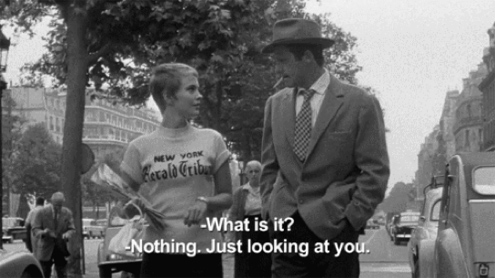À Bout de Souffle (Breathless) (1960)
Jean-Luc Godard, the director of À Bout de Souffle, always sought to encourage the audience to rethink what film could be in terms of both subject matter and the treatment of that subject matter. Godard once commented that ‘To me style is just the outside of content and content the inside of style; like the outside and inside of the human body both go together, they cannot be separated.’ [5]. It’s surely one of the most useful definitions that we can hold in our minds when we are studying film.
A key stylistic device of À Bout de Souffle is its use of jump cuts. The jump cuts are quite different to the usually transparent style of editing used in so much cinema. Godard wants us to notice that film is a construction. Furthermore this jump cut style breaks the conventions of the organization of movie narratives. Importantly, the film does not use artificial lighting to enhance its visual style.
The film plays with the illusion of time: we sometimes see the beginning and end of a piece of action but not the middle of it. There isn’t quite the clarity of communication we tend to expect of mass media. Godard, then, is playing with our expectation of continuity editing and the accepted sense of how a film will function and what the jump cuts do is represent the wayin which our own thoughts and feelings jump about from moment to moment. Of this challenge to the accepted norm, film scholar David Bordwell explains that art cinema (which the French New Wave could be classified as an example…
